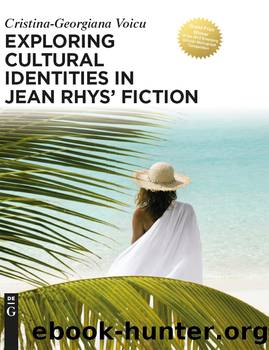Exploring Cultural Identities in Jean Rhys’ Fiction by Voicu Cristina-Georgiana

Author:Voicu, Cristina-Georgiana [Voicu, Cristina-Georgiana]
Language: eng
Format: epub
Publisher: De Gruyter Open Ltd
Published: 2014-10-01T16:00:00+00:00
4 Jean Rhys and Intertextuality
4.1 Authorship
In this subchapter, I will focus on feminist literary criticism, starting with two feminist critics who try to define what it means to be a woman writer in a patriarchal culture. Essentially, the “anxiety of influence” is about the writer’s “fear that he is not his own creator and that the works of his predecessors assume essential priority over his own writings” ( Gilbert and Gubar, 2000 , p. 46). Bloom’s Oedipal model of the ‘strong poet’, whereby a “man can only become a poet by somehow invalidating his poetic father” is undoubtedly a masculinist model but one, as such, eminently suited to understanding the patrilinearity of Western literary history and the “psychosexual and sociosexual contexts by which every literary text is surrounded” (Gilbert and Gubar, 2000 , p. 47).
By using a model of women’s cultural difference, I could argue that feminist critics can also incorporate ideas about their language, bodies and psyche, but they will “interpret them in relation to the social context in which they occur” ( Showalter, 2001 , p. 197). Cultural theories identify women’s “collective experience within the cultural whole”, whilst simultaneously acknowledging important differences amongst women writers. Just to concentrate on the notion of the ‘wild of women’s culture’, a zone spatially, experientially and metaphysically rushed outside the dominant boundaries, we may see that spatially it is a ‘no-man’s’ land; thus, forbidden to men, and experientially, includes parts of female lifestyle unlike those of men. In both these areas there are corresponding male zones, not open to women. Metaphysically, however – in terms of consciousness – there is no corresponding male experience alien to women. All male consciousness is within the boundaries of the dominant structures and thus accessible or structured by language. Although they have never experienced it first hand, women may know what male experience is like, since it has been the subject of myth and legend. But man can never know what is in the wild. It is always imaginary. “In their texts it becomes the place for revolutionary women’s language – the language of everything that is repressed” ( Showalter, 2001 , p. 201). Furthermore, the ‘wild zone’ represents the true arena for an examination of women’s difference. It is here that we will locate the essence of femininity. A cultural model of feminist criticism and women’s difference establishes the female tradition as a “positive source of strength and solidarity” as well as a “negative source of powerlessness”. Since women exist within two traditions simultaneously, feminist critics must address themselves to both dominant and muted structures.
Using the cultural model of gynocritics for Rhys’ Wide Sargasso Sea , we will get two different perceptions of reality corresponding to ‘dominant’ and ‘muted’ groups. Within the text these two axes come in a variety of forms. The most obvious is the male/female dichotomy. But there is also a racial divide, primarily between the British and Jamaican communities (e.g. the protagonist’s white Creole origin of mixed European and Negro descent).
Download
This site does not store any files on its server. We only index and link to content provided by other sites. Please contact the content providers to delete copyright contents if any and email us, we'll remove relevant links or contents immediately.
Kathy Andrews Collection by Kathy Andrews(10521)
The remains of the day by Kazuo Ishiguro(7551)
Spare by Prince Harry The Duke of Sussex(4199)
Paper Towns by Green John(4169)
The Body: A Guide for Occupants by Bill Bryson(3802)
Be in a Treehouse by Pete Nelson(3214)
Harry Potter and the Goblet Of Fire by J.K. Rowling(3046)
Goodbye Paradise(2964)
Never by Ken Follett(2884)
Into Thin Air by Jon Krakauer(2703)
The Remains of the Day by Kazuo Ishiguro(2620)
The Genius of Japanese Carpentry by Azby Brown(2609)
The Cellar by Natasha Preston(2595)
Drawing Shortcuts: Developing Quick Drawing Skills Using Today's Technology by Leggitt Jim(2532)
120 Days of Sodom by Marquis de Sade(2439)
Architecture 101 by Nicole Bridge(2351)
The Man Who Died Twice by Richard Osman(2300)
Machine Learning at Scale with H2O by Gregory Keys | David Whiting(2293)
Fairy Tale by Stephen King(2072)
